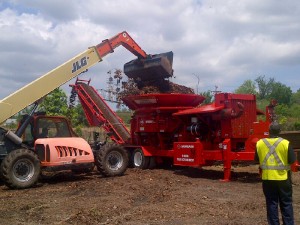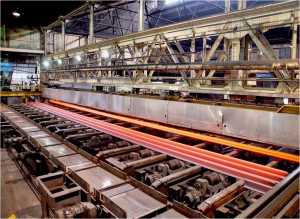Metro’s new large tub grinder, called “Chip”, will pay for itself in 4 years.

Metro’s New Tub Grinder “Chip”
With summer now underway, Metro’s Grounds Maintenance and Custodial Services (GMAC) staff are out throughout the system addressing the management of vegetation and landscaping on Metro property. This year, GMAC has a new piece of equipment to both reduce operating costs and improve operational efficiency. “Chip”, the tub grinder funded by Metro’s Sustainability Lab, is expected to save Metro approximately $50,000 in waste disposal and landscaping costs annually.
Chip allows for compostable waste such as leaves, landscape debris, and wood debris (e.g. pallets, shipping crates, etc.) from Metro facilities to be ground up and converted into mulch. This mulch can then be diverted from the waste stream and instead reused in landscaping on Metro property. Chip is anticipated to divert approximately 4,000 cubic yards of compostable waste from the waste stream per year and is anticipated to recoup the initial investment on the equipment in three to four years.
This closed loop recycling program will not only reduce Metro expenditure but will also move Metro closer to its long term goal of zero waste that forms part of Metro’s Sustainability Initiative.

Rail Fabrication Process at ArcelorMittal, Steelton – Image Courtesy of ArcelorMittal
On a daily basis the Metrorail track infrastructure system is subject to the stress and strain of operational and climatic variations. Combining a proactive maintenance program with the latest in rail materials and technology, Metro upholds a commitment to the highest levels of system-wide safety, passenger comfort, operational sustainability, and reliability. System maintenance under the Federal Transit Administration State of Good Repair program has allowed Metro to maintain its commitment to an aggressive “fix it first” policy that features:
“New” Rail is 100% recycled steel – For all replacement rails Metro uses a premium head-hardened rail made from 100% recycled steel. These rails are the highest possible quality available and have the longest possible service life. The rail is fabricated using a controlled water jet system that evenly dissipates heat during the fabrication process to create deep, head-hardened layers through each rail.
Continuously Welded Rail increases system efficiency– Using a state-of-the-art flash-butt welding system Metro has a system-wide program of rail joint elimination to improve ride quality and cut service disruptions. Flash-butt welding applies a strong electrical current to the touching ends of two sections of rail. The ends become white hot due to electrical resistance and can then be fused together to form a single rail. The new continuously welded rail is strong, gives a smoother passenger ride, and allows trains to travel with less friction – thereby increasing system efficiency.
Through Metro’s comprehensive rail-infrastructure maintenance program, upgrades are put in place for the future of the system and transit in the region.
This post forms part of a series featuring content from Metro’s Sustainability Agenda, part of Metro’s Sustainability Initiative.




Recent Comments